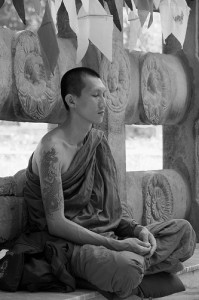What is Vipassana Meditation ?
Vipassana is an ancient Indian form of mediation which has been practiced for thousands of years. The exact origins of the meditative technique are unclear but we do know it was rediscovered by Gotama the Buddha about two and a half thousands years ago.
Vipassana is also commonly referred to as thought watching or sensory meditation. It takes this name because it teaches us to see the world as it really is. Another way of thinking of Vipassana is as a method of purifying oneself through the process of self-observation.
Vipassana is used to bring health and happiness to the mind, body and soul. It offers a cure for spiritual and physical ailments and as such is

By: José Antonio Morcillo ValencianoIntroduction to Vipassana Meditation: Silence allows for great insight
termed an art of living. Vipassana is method by which we can achieve mental purity and thus face the challenges of life in a balanced way.
One of the key differences between Vipassana and other types of meditation is that it can only be taught at a ten day residential retreat. The majority of this retreat is performed in complete silence. You are unable to learn Vipassana meditation from a book, DVD or one to one session.
Benefits of Vipassana Meditation
There are a number of benefits to practising Vipassana meditation. When you go on a Vipassana retreat you will need to spend nine of out of ten days in complete silence. This period of silence allows you to see things in your life with clarity. Gaining this deeper level insight into your life is just one of the benefits to this type of meditation. You will also become more accepting, experienced increased creativity, gain self-awareness, and become less stressed.
By practicing Vipassana meditation you are bringing the mind into a state where it is detached but still observant of the thoughts that arise. When we have thoughts or desires that we didn’t think are appropriate they are placed into the subconscious mind. Even though we may not be consciously aware these thoughts they can still cause us to feel stressed or unhappy. Vipasanna allows you to see these thoughts, acknowledge them and work on reprogramming the mind so that you are able to live a happier and more centered life.
Understanding the Mind
To understand the Vipassana method it is useful to look at how our conscious mind works. The process begins with some external or internal stimuli. This might be the sound a dog barking, the smell of freshly baked bread or even a thought.
This data is received by our consciousness and immediately thereafter we place a perception or an evaluation on that information. In essence we say to ourselves whether we like it or we don’t like it. This perception is based on our past experiences, both in our own lives and those going back generations.
As soon as our mind places an evaluation a sensation will appear in and in on our body. This might be a hazy sensation, a pulse, or a pressure. When this sensation is pleasant people begin to crave the stimuli that caused that sensation. Understanding the connection between the mind and the body is central to the practice of Vipassana.
Vipassana is Available to Everyone
While the teachings of Vipassana are handed down from the Buddha the practice is not limited Buddhists. Anyone can learn and use the techniques no matter their religious background or beliefs. Many different people, both religious and atheist, practice Vipassana without it conflicting with their other forms of worship.
Observing the Noble
One of the most challenging aspects of attending a Vipassana retreat is observing what is called the noble silence. For the first nine days of the retreat you will be required not to talk to anyone accept to ask questions of the teacher. You may also ask the facilitators questions about accommodation, food or any other problems. The key is to think of the process as a solitary endeavour, even though there will be other people around you. All forms of communication including written word or sign language are not allowed.

Introduction to Vipassana Meditation: Observing the Noble Silence
Going Beyond the Ten Day Retreat
It is important to understand that the ten day retreat is the beginning to the practice of Vipassana and not the end. The ten day retreat will teach the student the proper technique so that they can apply it in to their daily life. Making Vipassana a regular part of your life is what will allow you to move towards the ultimate goal of liberation and freedom from misery.
Have you ever tried this practice let me know.